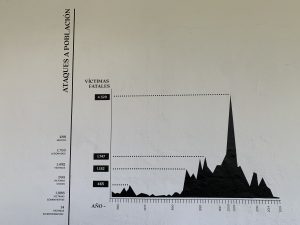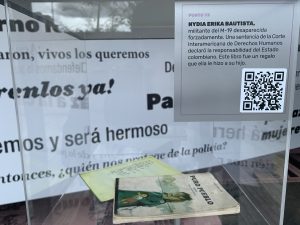by Nathan Leung
“Hay futuro si hay verdad” – there is a future if there is truth. This was Colombia’s Comision de la Verdad’s (Truth Commission) slogan for their Final Report. The report, released on June 28, 2022, consisted of interviews from victims, armed actors, law enforcement officers, and former presidents, among other stakeholders, about the causes and consequences of Colombia’s armed conflict.
This release was among one of the major events that happened this summer. Coincidentally, I came to Colombia at a time when there were many changes. This year marked the first time that a left-wing president was elected in Colombia. Erring on the side of caution, I was asked to stay home when the first and second round of elections occurred in May and June, before Gustavo Petro was elected and came into office in August.
In June, the International Criminal Court (“ICC”) rejected the petition to reopen the preliminary examination on allegations of human rights abuses in Colombia. This preliminary examination was closed in 2021 when the ICC Prosecutor, Kharim Khan, came to Colombia and determined that the country’s government did not lack volition to look into these crimes. Therefore, the cases during the armed conflict should be best dealt with internally. This led to a change in my assigned research to summarize the reasons for the rejection rather than to find reasons to invite Prosecutor Khan to Colombia for the appeal.
Prior to this internship, I only knew about drug trafficking issues in Colombia. Only after arriving did I realize that drugs formed part of a bigger conflict – the armed conflict. This conflict has been ongoing since 1964 and primarily involves the Colombian government, far-left guerilla groups such as ELN and FARC, far-right paramilitary groups that arose to “protect themselves” from the guerillas such as AUC, and illegal criminal organizations that participate in drug and human trafficking.
In 2016, the Colombian government and FARC signed the Final Agreement, which focuses on six main areas: ending the armed conflict; truth, justice, and reparation for victims; fighting drug trafficking; better rural opportunities; more political participation and democracy; and implementation of the Final Agreement. In 2017, FARC demobilized and transitioned into a political party. Nevertheless, government negotiations are still ongoing with ELN, and FARC dissidents have been responsible for several attacks in the country.
The Final Agreement created three institutions for transitional justice: the Truth Commission, the Special Jurisdiction for Peace (“JEP”), and the Search Unit for Disappeared People (“UBPD”). The JEP is a tribunal that specifically deals with cases from the country’s armed conflict. One of the goals of ASFC’s JUSTRAM (Transitional Justice for Women) project, was to increase confidence in the country’s transitional justice institutions.
JUSTRAM aimed to reinforce this by going into communities most affected by the armed conflict, and working together with leaders of women’s groups. ASFC members taught these women about the possible recourse they had for the violence they encountered during the armed conflict. At the time that I came to Colombia, JUSTRAM was set to end in June, and it had been a five year project ever since the Final Agreement was signed in 2016.
One of my most memorable moments was during the closure event for JUSTRAM. An indigenous woman from one of the groups that ASFC worked with asked me if there was a Unit for Displaced Victims (Unidad de las Víctimas) in Canada. I responded no, we don’t have such a victims unit, but we still have many displaced Indigenous peoples in Canada, similar to Colombia.
This question made me deeply reflect on our Indigenous issues in Canada. Although we do not have an ongoing armed conflict, we have displaced our Indigenous peoples. Our government forced them into residential schools, relocated the Metis in the 1800s, and relocated the Inuit in 1950. Even the fact that Indigenous peoples do not comprise the majority of the population in major Canadian cities points to how they have been forced to move onto reserves. In JUSTRAM, Indigenous, Black, and rural women were the focus groups, and I found that this demographic did not differ greatly from Indigenous and racialized groups who are also significantly disadvantaged in Canada.
Outside of the office, I was also able to learn more about the issues in Colombia. One of the buildings in Bogota’s historic centre had a temporary photo exhibit on the armed conflict. I found it much easier to grasp the information I was reading at work with the presented visuals as the thick books felt impersonal at times. The photo exhibit discussed multiple atrocities committed by the state and armed groups, but what caught my eye the most was a series of graphs showing the number of victims for different types of violence (forced disappearance, kidnappings, displacement, sexual violence). Most of the graphs showed that civilians were the largest group affected by this violence; however, for attacks on civilians, combatant victims were almost as many as civilians.

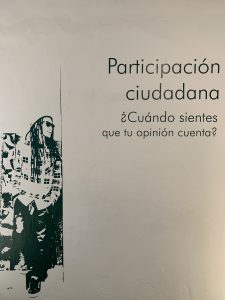
This graph reminded me that although civilians are the focus of human rights, armed groups can also be the victims and will have different points of view. This was further reinforced when I went to the Centre for Memory and Reconciliation, which exhibited items from members of the M-19 armed group who had forcibly disappeared.
What I did find lacking in the reports and exhibitions were stories from family members of those who had forcibly disappeared. The truth of the incidents was not incorrectly remembered as it included militant victims, but rather, it was incomplete.
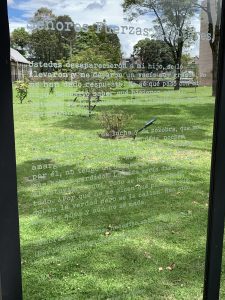
The Centre also had a children’s section where events were regularly held. I saw many books along the wall, and asked one of the curators what they were for. She told me that they were books to teach children about the armed conflict. Curious as to how it would be taught, I read one related to displacement and found that the concept was explained in a rather abstract way. The story begins with the child remarking that one day, they woke up and everything seemed different. However, nobody around them seemed to notice. The story ends with the child accepting their new home and the differences.
Personally, I felt that the story didn’t differentiate between a family moving for work purposes or immigrating on their own volition from a case of forced movement. However, I suppose that this would be discussed with the children in the events that were held in the Centre. The curator also told me that war was easier for children to understand than concepts such as their internal conflict or enforced disappearances, as children were more exposed to war through media such as video games. I found this interesting in that a more local issue was less in the minds of children. Conversely, Canadian children are rarely taught about Indigenous issues in the country but rather learn about events such as the Holocaust which happened a continent away.
Needless to say, whenever I was told by a Colombian that Canada as a “first world country” must have better rights than a “third world country” like Colombia, it was quite unsettling to me. Canada’s human rights issues kept circling back, and in some areas such as LGBTQ rights, I found Colombia to be quite progressive and arguably on-par with Canada in some areas.
For instance, there were ample pro-LGBTQ messages posted by the government on streets, advertisements telling people to denounce discrimination against LGBTQ communities, and LGBTQ media was readily available in cinemas and bookstores. The LGBTQ community was also identified as one of the target groups to work with in the Final Agreement, and even if progress is still to be made, at the very least LGBTQ people were not forgotten as a stakeholder.
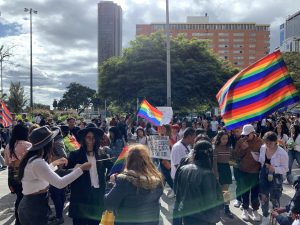
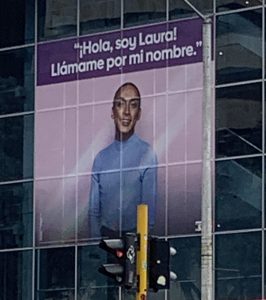
There was also progress in the area of migrants’ rights when I heard about Yolanda’s case, known formally as Sentencia T-236/21, in events that ASFC held about human trafficking. Yolanda was a Venezuelan migrant who was falsely lured to Colombia. She was unable to obtain protection as a human trafficking victim, and fought for her rights to be recognized as such. With the help of an organization called Women’s Link, Yolanda’s rights as a human trafficking victim were recognized by the Constitutional Court, and better protection for human trafficking victims was achieved. A victim identification protocol was to be designed along with better training for public officials to identify human trafficking victims.
In terms of the armed conflict, a historic moment that happened this summer was an acknowledgment hearing held by JEP. This hearing was the first time that ex-FARC members admitted responsibility for crimes such as kidnapping. Families of victims attended the hearing and attended restorative justice meetings with the ex-FARC members. In addition to the Centre for Memory, another Memory museum was to be built and originally planned to open in 2022. This museum will have permanent exhibits, unlike the Centre for Memory, which is more focused on events and school education.
All of these positive aspects made me doubt whether Colombia was really as “undeveloped” as Colombians framed it to be, but it was not until we had one of our class discussions that I realised the key to this issue.
Rather than comparing Colombia with Canada or European countries, it is better to look at Colombia in the context of other Latin American countries with similar income and development. Time and time again, I saw progress in the country during this internship, and I see how much hope the country is filled with for a better future. Time will tell the effects of the ongoing change, but the reconciliation attempts underway and the efforts to recognize rights of diverse groups such as LGBTQ people and migrants seem to point towards a positive trend.
Although it may be tempting to point out the flaws in the reconciliation process or what has yet to be achieved, people are seeking the truth, reconciliation, and remembrance of those who have been lost. True to the Truth Commission’s slogan, there is a future, if there is truth.

